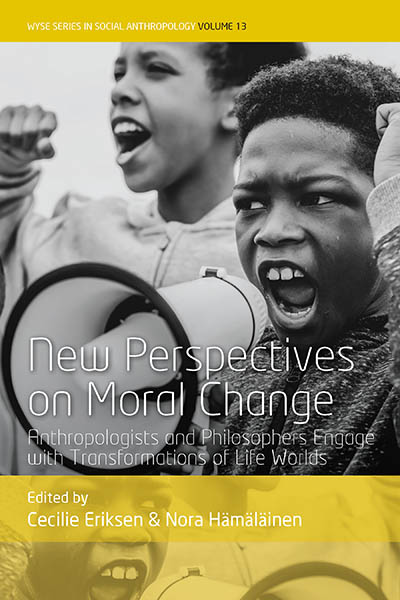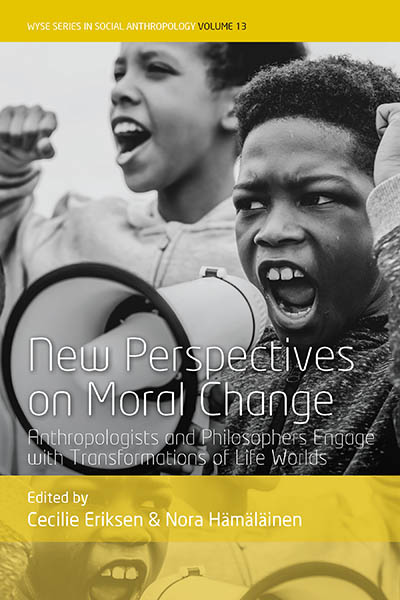
In our interview with Cecilie Eriksen and Nora Hämäläinen, the editors of New Perspectives on Moral Change, volume 13 in the WYSE Series in Social Anthropology, they explain the thinking behind their work, how they found their contributors, and the range of issues that they tackled.
Dr Eriksen, Dr Hämäläinen, thank you for joining us. Before we begin discussing your new book would you please tell us about your work and main areas of study?
Cecilie Eriksen: Thank you for the invite to join the blog.
I work as a special consultant for the National Center for Ethics under the Danish Health Ministry, and I am an affiliated researcher at the Dutch research program ESDiT (https://www.esdit.nl/) and at the research project ‘Progress’ (https://progress.sites.uu.nl/).
My main area of study is moral philosophy. I have specialized in the topic of moral change and hereunder sub-topics such as the dynamics of moral change, moral progress, and moral revolutions. I also have a side interest in the thinking of the later Wittgenstein.
Nora Hämäläinen: I have for the past four years worked as senior researcher at the Centre for Ethics as Study in Human Value, at the University of Pardubice, Czech Republic. I am soon shifting my affiliation to my alma mater, the University of Helsinki, Finland, where I am a Docent and will work as University Researcher.
I have previously worked on philosophy and literature, descriptive ethics, virtue ethics, philosophical method, questions of historicity in ethics, moral change, and moral personhood. At this very moment I am finalizing a monograph on philosophy and self-help literature, forthcoming at Routledge.
Your book tackles a fascinating subject, understanding the moral shifts that result from changes in society. What drew you to it?
CE: My research on moral change started out as a curiosity about what are actually the ‘moral resources’ for people who engage in radical moral critique of their societies?
If Nietzsche discarded all the moral values of his society and time as ethically empty, which ethical ideals and creative moral resources were then at his disposal? This was roughly the form, the conundrum that I had started pondering.
Later in my research, I found that this way of putting things suggests a misleading image of radical moral critique and reading Jonathan Lear’s Radical Hope was a huge help in setting the direction for my research on moral change. But it was questions about the above that started the journey that led, among other things to the, anthology that Nora and I edited for Berghahn Books.
NH: The topic of moral change has in some sense been with me from the beginning of my research trajectory. I began my doctoral studies at the University of Helsinki in 2004 with a project on how analytic moral philosophers relate to the question of historicity. That was a real puzzlement, because despite prominent historically oriented figures such as Charles Taylor, Alasdair Macintyre and Bernard Williams, the questions of historicity (and the interrelated question of contextuality) didn’t seem to play much of a role for the ways moral philosophy was done. As a PhD project it was, however, shapeless and ill conceived, so I diverted into writing about how moral philosophers such as Martha Nussbaum, Iris Murdoch and Cora Diamond have turned to narrative literature for a more fleshed out, contextually aware approach to ethics. This was for me a different, more manageable way of tackling the same cluster of questions around ethics, change, historicity, and contextuality. I have been glad to see that there is more room for these kinds of considerations in today’s moral philosophy, but there is a lot to do in this area.
Moral change is a key issue when thinking about ethics in context, and it is also one of the difficult issues for moral philosophers, because it seems to undermine much of what philosophers do in both normative ethics and meta-ethics.
Would you give us some idea of the extraordinarily wide range of issues the collection covers?
CE: The introduction gives an overview of how moral change has been conceptualized in anthropology and (western) philosophy, as well as how influential research trajectories in moral philosophy and moral anthropology have evolved in both opposite and parallel directions over the last 100 years.
The rest of the anthology investigates moral change though topics such as marriage, queer life, radical religious change, moral injury and loss of self, dementia care, ethical experience, moral revolutions, ethics in liminal spaces, moral truth, moral disagreement and conceptions of fatherhood.
NH: It is striking, in a way, that you say it covers an extraordinarily wide range of issues. It sems to me that these issues come together very naturally for both Cecilie and me, not as a ready academic speciality called “moral change,” but as conducive to a distinctive way of looking at morality, moral life, moral inquiry, human community, and social change.
Borrowing an expression from Bruno Latour, the book is an attempt at “assembling the collective” of moral thought in a way that we find helpful for moving forward. This “collective” involves not just the authors, but also the different places, topics, material objects, references, scholarly traditions, and sensibilities that present themselves in these texts. I hope some readers can get the sense that this is a good collective to join.
How did you go about finding your contributors and what’s the ratio of anthropologists to philosophers?
CE: We started out by contacting researchers, who had published influential work on various forms of moral change (such as moral revolutions, radical moral change, moral progress, etc.), but to some extent we also used our own research networks.
The anthology has four chapters written by anthropologists, one chapter by a philosopher who has completed an anthropological field study, one chapter was written by researchers with a background in theology, and then five chapters were written by philosophers, many of which are informed by engagement with literature, anthropology and historical research.
NH: As always with these kinds of projects, things happen on the way and the eventual line-up is different than the original plan. I think we ended up with very good group and strong papers from authors who contribute to creating the kind of discussion that we hoped for.
Cecilie, your chapter (Moral Borderlands: Ethical Normativity in Liminal Spaces) and the Introduction, written with Nora, are also Open Access. How did that come about?
CE: I was so lucky to have a postdoc in an ERC-funded project at The Ethics Institute at Utrecht University in the Netherlands while I wrote the introduction and the main part of my chapter. The ERC requires – and funds – that the research in their projects is published Open Access.
Overall, what do you hope your book will contribute to our thinking on moral change?
CE: We hope that the book will be part of making the topic of ‘moral change’ more prominent in both philosophy and anthropology, and we also hope that the book will support the current cross-disciplinary engagement between anthropology and philosophy, as we find the disciplines can benefit tremendously from each other.
From an ethical point of view, I often find that the quality of work done in anthropology today is significantly higher than much of what unfolds in contemporary philosophy. To quote the intro of the anthology: “A significant attraction for moral philosophers in the work of moral anthropologists is that the latter often produce texts radiant with an ethical sensibility, beauty and attention to the paradoxes of human life only rarely seen in the long tradition of moral philosophy. Here we witness what it means to incarnate ‘the point of view from which we see and attend with warmth and sympathy to the complex reality of human life’ (Diamond 1997: 246)”.
Cora Diamond did not write this about moral anthropology. In 1997 her words were formed as a wish for a future vibrant moral philosophy, relevant for human life. For us, this type of moral philosophy has materialized in modern moral anthropology.
NH: I know that there are a lot of young scholars in moral philosophy who look for the kinds of contextualized perspectives that anthropological work can provide, and young anthropologists who are concerned with questions of morality or ethics in a changing world. I hope the book can contribute to making the intersection between moral philosophy and anthropology more hospitable; that it can strengthen the feeling that this is a place to be and move around, and that there are ample resources to draw upon. The authors in this book contribute with their different perspectives and matters of concern, but also their different frames of reference. I have learned a lot about possible approaches to moral change while working on this project, and I hope readers can get the same sense of rich possibility.
And what’s next for you both now? Do you plan to explore the subject further?
CE: That is certainly the plan. For the last year, I have been engaged in an investigation of moral changes due to the increased use of decision-making and decision-supporting AI (artificial intelligence) in the public sector in Denmark and Europe. I have been focussing on changes to what one (with some reservation) can call ‘the moral paradigm’ and moral ethos, which has been informing law-making and caseworkers in the public sector of the Danish Society (and parts of Europe) for the last 70 years.
NH: For the next three years I will work on two different projects: a research project on moral change (in English) and an essayistic book on loneliness, intended for a general audience (in Swedish). Both have to do with ethics and social change, but in different ways, allowing different paths of exploration.
I have had this idea of writing a book on moral change for several years, but for a long time there were far too many chapters squandered on quibbling with main-stream moral philosophy in my plan. There is also more literature on the topic around now – including Cecilie’s great book Moral Change: Dynamics, Structure, and Normativity (Palgrave Macmillan 2020) – that has helped me to clarify the direction of my contribution. I’m particularly interested in the interplay of ethics and the material conditions of human life, and also how question of materiality link to everyday practices, language, and worldview. Current anthropological interest in infrastructures is also something that I make use of for this purpose. Thinking about these things makes me impatient and eager to move ahead, but these kinds of projects always take time, of course.

Want to read more? View and download the Introduction or visit the book’s webpage for its table of contents and to recommend it to your library.
If you want to know more about our books please sign up for our email newsletters in the subjects of your choice.
